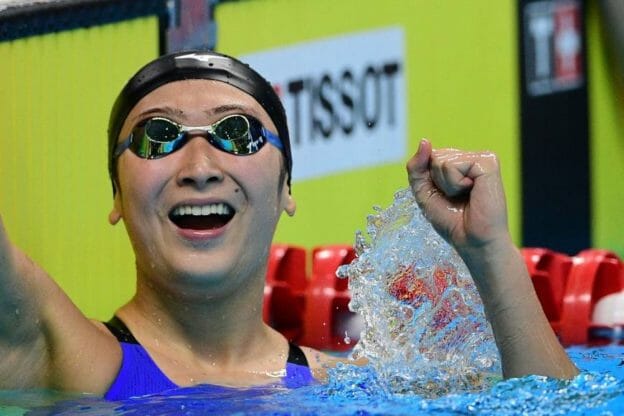Rikako Ikee has already proven to be one of the fastest women butterfly swimming competitors in the world. Watching Rikako swimming butterfly, you will see that she has very high recovering arms on both sides; a very vertical arm recovery compared to most. Her hands are well above her elbows on her recovery. Lazlo Cseh of Hungary has a similar recovery among the men’s butterfly swimming.
The advantage of a more vertical recovery in swimming butterfly is that the gravitational force assists in the arms coming down to the water more forcefully when compared to a more common horizontal recovery. The higher kinetic energy of the arms at entry couples with the second down kick and enables the swimmer to surge forward faster after this second butterfly kick.
In order to do this vertical recovery in swimming butterfly, the swimmer needs to have extraordinarily high extension flexibility of the shoulders. At The Race Club, we grade all of our swimmers for flexibility in all of the important joints used in swimming. In the butterfly swimming stroke and the freestyle swimming stroke, the ability of the swimmer to extend the shoulders backwards is a key advantage. With both of these swimming strokes extension of the shoulders helps in the recovery motion and in the high elbow pulling motion.
With the arms held at shoulder level height, back straight and palms facing downward, we extend the arms backwards holding the arms near the elbows until the force produces some discomfort to the swimmer. If the elbows are a few inches apart when that occurs, we would score that as a 6. With one inch of separation, it is a 7. Barely touching the elbows together would be considered an 8. Overlapping elbows is a 9 and when the elbows can move past each other, that is a 10.
Every swimmer that I have seen that can use Rikako’s butterfly technique has an 8, 9 or 10 score on shoulder extension. Even those swimmers that have the extra shoulder flexibility may still be challenged with this high arm recovery technique, as it requires more attention and work to accomplish than a lower arm recovery.
I do believe that coupling with the arms and head (and to lesser extent the shoulders) can be a powerful technique in butterfly. The extra effort of Rikako’s high arm recovery, for those able to do so, may be well worth the effort.
This week in Lanes 2, 3 and 4 you will find a valuable webisode on another important coupling motion for freestyle swimming, body rotation. For those in Lanes 3 and 4, you will find some very good data on distance ace Zane Grothe on why the body rotation is so important in freestyle swimming. We hope you will enjoy them. In Lanes 3 and 4, American record holder Zane Grothe will show you why you need to keep your toes pointed coming off the walls on your turns.
Yours in butterfly swimming,
Gary Sr.

